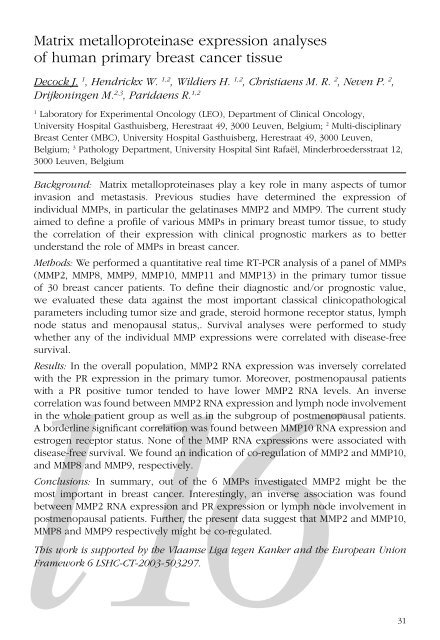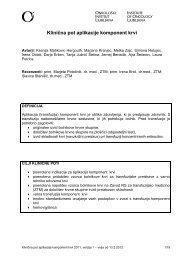Create successful ePaper yourself
Turn your PDF publications into a flip-book with our unique Google optimized e-Paper software.
Matrix metalloproteinase expression analyses<br />
of human primary breast cancer tissue<br />
Decock J. 1 , Hendrickx W. 1,2 , Wildiers H. 1,2 , Christiaens M. R. 2 , Neven P. 2 ,<br />
Drijkoningen M. 2,3 , Paridaens R. 1,2<br />
1<br />
Laboratory for Experimental Oncology (LEO), Department of Clinical Oncology,<br />
University Hospital Gasthuisberg, Herestraat 49, 3000 Leuven, Belgium; 2 Multi-disciplinary<br />
Breast Center (MBC), University Hospital Gasthuisberg, Herestraat 49, 3000 Leuven,<br />
Belgium; 3 Pathology Department, University Hospital Sint Rafaël, Minderbroedersstraat 12,<br />
3000 Leuven, Belgium<br />
Background: Matrix metalloproteinases play a key role in many aspects of tumor<br />
invasion and metastasis. Previous studies have determined the expression of<br />
individual MMPs, in particular the gelatinases MMP2 and MMP9. The current study<br />
aimed to define a profile of various MMPs in primary breast tumor tissue, to study<br />
the correlation of their expression with clinical prognostic markers as to better<br />
understand the role of MMPs in breast cancer.<br />
Methods: We performed a quantitative real time RT-PCR analysis of a panel of MMPs<br />
(MMP2, MMP8, MMP9, MMP10, MMP11 and MMP13) in the primary tumor tissue<br />
of 30 breast cancer patients. To define their diagnostic and/or prognostic value,<br />
we evaluated these data against the most important classical clinicopathological<br />
parameters including tumor size and grade, steroid hormone receptor status, lymph<br />
node status and menopausal status,. Survival analyses were performed to study<br />
whether any of the individual MMP expressions were correlated with disease-free<br />
survival.<br />
l16<br />
31<br />
Results: In the overall population, MMP2 RNA expression was inversely correlated<br />
with the PR expression in the primary tumor. Moreover, postmenopausal patients<br />
with a PR positive tumor tended to have lower MMP2 RNA levels. An inverse<br />
correlation was found between MMP2 RNA expression and lymph node involvement<br />
in the whole patient group as well as in the subgroup of postmenopausal patients.<br />
A borderline significant correlation was found between MMP10 RNA expression and<br />
estrogen receptor status. None of the MMP RNA expressions were associated with<br />
disease-free survival. We found an indication of co-regulation of MMP2 and MMP10,<br />
and MMP8 and MMP9, respectively.<br />
Conclusions: In summary, out of the 6 MMPs investigated MMP2 might be the<br />
most important in breast cancer. Interestingly, an inverse association was found<br />
between MMP2 RNA expression and PR expression or lymph node involvement in<br />
postmenopausal patients. Further, the present data suggest that MMP2 and MMP10,<br />
MMP8 and MMP9 respectively might be co-regulated.<br />
This work is supported by the Vlaamse Liga tegen Kanker and the European Union<br />
Framework 6 LSHC-CT-2003-503297.

















